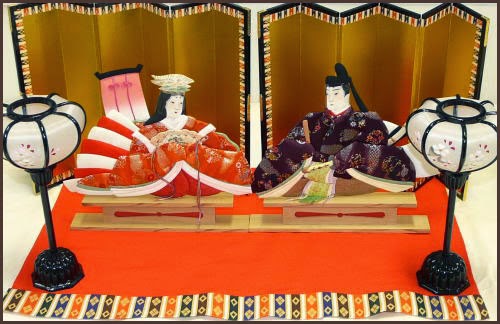LINK
http://fudosama.blogspot.jp/2004/12/goshiki-fudo-fudo-in-five-colors.html
:::::::::::::::::::::::::::::::::::::::::::::::::::::::::::::::::::::::::::::::::::::::::::::::::::::::
The Eyes of Fudo Myo-O 不動明王の目

8 The left eye is closed, the right one wide open.
8 左の目を閉じ右の目を開いている.
tenchigan, tenchi gan 天地眼
"eyes (and teeth) of heaven and earth"
The left eye is facing heaven, the right eye is facing earth.
The same holds for his left and right fang.
. 19 Characteristic Signs of Fudo Myo-O .
不動十九観 / 不動十九相観
The left eye is squinting or looking askance.
- quote
His face is characterized by the tenichi-gan arrangement of the teeth and eyes: the right eye is open and swollen, looking straight ahead, with the bottom right tooth pointing up;
the left eye is downcast and narrowed while the top left tooth projects downward.
- source : www.humanities360.com
Sample from Rokusho Kitan 六菖綺譚


source : www.rokushokitan.com
:::::::::::::::::::::::::::::::::::::::::::::::::::::::::::::::::::::::::::::::::::::::::::::::::::::::
江戸の五色不動明王 Goshiki Fudo
The Five Fudo with different colored eyes in Edo
(ごしきふどう)

Good explanation in Japanese:
http://www.h2.dion.ne.jp/
My Article about the symbol of the five colors
- Goshiki Color Symbols -
Temple Ryusenji (Meguro Fudo 目黒不動) is the oldest Fudo temple in Japan and counted as one of Japan's three largest Fudo temples, the 18th temple of the Kanto Pilgrimage Temples of 36 Fudo Myo-O, one of Edo Goshiki Fudo (Five Different-colored Fudo statues in Edo) to protect the Castle of Edo.
:::::::::::::::::::::::::::::::::::::::::::::::::::::::::::::::::::::::::::::::::::::::::::::::::::
日本語のリンク Japanese LINKS
五色不動 各寺院の沿革
Meguro Black 目黒不動 天台宗 龍泉寺
(目黒区下目黒3丁目)地名にもなった五色不動の中では一番大きなお不動様。
Mejiro White 目白不動 真言宗 豊山派金乗院
(豊島区高田2丁目)もと新長谷寺 (文京区関口2丁目)にあったが戦災で廃寺になったために金乗院に移転。
Me-ao Green (blue) 目青不動 天台宗 教学院
(世田谷区太子堂4丁目)もとは港区麻布谷町(現:六本木)の勧行寺(または正善寺)にあったが1882(明治15年)青山南町にあった教学院に移転。教学院は1910(明治43年)世田谷区太子堂に移転。

Me-aka Red 目赤不動 天台宗 南谷寺 (文京区本駒込1丁目)もともと三重県赤目山で授かった赤目不動が本尊で、家光の勅令で目赤に改名。
Meki Yellow 目黄不動 天台宗 永久寺
(台東区三輪2丁目)と天台宗 最勝寺(江戸川区平井1丁目 旧所在地は、本所区東駒形)目黄不動だけは、なぜか複数存在する。他にも渋谷の龍巖寺など全部で六ヶ所あるようだ。(未確認情報)

Map of the temples

© http://suzuki-t.hp.infoseek.co.jp/5fudou.htm
:::::::::::::::::::::::::::::::::::::::::::::::::::::::::::::::::::::::::::::::::::::::::::::::::::
Aka Fudo 目赤不動 Red
Aoi Fudo 青不動 Blue .
Ki Fudo 黄不動 Yellow - TBA -
Kuro Fudo 黒不動 Black
Shiro Fudo 白不動明王 White
:::::::::::::::::::::::::::::::::::::::::::::::::::::::::::::::::::::::::::::::::::::::::::::::::::::

goma seihai 護摩聖灰 sacred ashes from a Goma fire ritual
in Fudo five colors (goshiki)
. Fukagawa Fudo Do (Fudoo Doo) 深川不動堂 .
[ . BACK to WORLDKIGO . TOP . ]
[ . BACK to DARUMA MUSEUM TOP . ]
:::::::::::::::::::::::::::::::::::::::::::::::::::::::::::::::::::::::::::::::::::::::::::::::::::::
http://fudosama.blogspot.jp/2004/12/goshiki-fudo-fudo-in-five-colors.html
:::::::::::::::::::::::::::::::::::::::::::::::::::::::::::::::::::::::::::::::::::::::::::::::::::::::
The Eyes of Fudo Myo-O 不動明王の目

8 The left eye is closed, the right one wide open.
8 左の目を閉じ右の目を開いている.
tenchigan, tenchi gan 天地眼
"eyes (and teeth) of heaven and earth"
The left eye is facing heaven, the right eye is facing earth.
The same holds for his left and right fang.
. 19 Characteristic Signs of Fudo Myo-O .
不動十九観 / 不動十九相観
The left eye is squinting or looking askance.
- quote
His face is characterized by the tenichi-gan arrangement of the teeth and eyes: the right eye is open and swollen, looking straight ahead, with the bottom right tooth pointing up;
the left eye is downcast and narrowed while the top left tooth projects downward.
- source : www.humanities360.com
Sample from Rokusho Kitan 六菖綺譚


source : www.rokushokitan.com
:::::::::::::::::::::::::::::::::::::::::::::::::::::::::::::::::::::::::::::::::::::::::::::::::::::::
江戸の五色不動明王 Goshiki Fudo
The Five Fudo with different colored eyes in Edo
(ごしきふどう)

Good explanation in Japanese:
http://www.h2.dion.ne.jp/
My Article about the symbol of the five colors
- Goshiki Color Symbols -
Temple Ryusenji (Meguro Fudo 目黒不動) is the oldest Fudo temple in Japan and counted as one of Japan's three largest Fudo temples, the 18th temple of the Kanto Pilgrimage Temples of 36 Fudo Myo-O, one of Edo Goshiki Fudo (Five Different-colored Fudo statues in Edo) to protect the Castle of Edo.
:::::::::::::::::::::::::::::::::::::::::::::::::::::::::::::::::::::::::::::::::::::::::::::::::::
日本語のリンク Japanese LINKS
五色不動 各寺院の沿革
Meguro Black 目黒不動 天台宗 龍泉寺
(目黒区下目黒3丁目)地名にもなった五色不動の中では一番大きなお不動様。
Mejiro White 目白不動 真言宗 豊山派金乗院
(豊島区高田2丁目)もと新長谷寺 (文京区関口2丁目)にあったが戦災で廃寺になったために金乗院に移転。
Me-ao Green (blue) 目青不動 天台宗 教学院
(世田谷区太子堂4丁目)もとは港区麻布谷町(現:六本木)の勧行寺(または正善寺)にあったが1882(明治15年)青山南町にあった教学院に移転。教学院は1910(明治43年)世田谷区太子堂に移転。

Me-aka Red 目赤不動 天台宗 南谷寺 (文京区本駒込1丁目)もともと三重県赤目山で授かった赤目不動が本尊で、家光の勅令で目赤に改名。
Meki Yellow 目黄不動 天台宗 永久寺
(台東区三輪2丁目)と天台宗 最勝寺(江戸川区平井1丁目 旧所在地は、本所区東駒形)目黄不動だけは、なぜか複数存在する。他にも渋谷の龍巖寺など全部で六ヶ所あるようだ。(未確認情報)

Map of the temples

© http://suzuki-t.hp.infoseek.co.jp/5fudou.htm
:::::::::::::::::::::::::::::::::::::::::::::::::::::::::::::::::::::::::::::::::::::::::::::::::::
Aka Fudo 目赤不動 Red
Aoi Fudo 青不動 Blue .
Ki Fudo 黄不動 Yellow - TBA -
Kuro Fudo 黒不動 Black
Shiro Fudo 白不動明王 White
:::::::::::::::::::::::::::::::::::::::::::::::::::::::::::::::::::::::::::::::::::::::::::::::::::::

goma seihai 護摩聖灰 sacred ashes from a Goma fire ritual
in Fudo five colors (goshiki)
. Fukagawa Fudo Do (Fudoo Doo) 深川不動堂 .
[ . BACK to WORLDKIGO . TOP . ]
[ . BACK to DARUMA MUSEUM TOP . ]
:::::::::::::::::::::::::::::::::::::::::::::::::::::::::::::::::::::::::::::::::::::::::::::::::::::





































